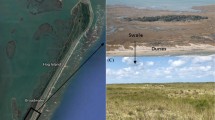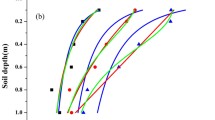Abstract
Whether and why the biomass–density (M–N) scaling relationship varies along environmental gradients were continuously debated in theoretical ecology. In this study, how soil salinity stress affects on the M–N scaling relationship was investigated by using Suaeda salsa L. in beach of Dongtai, Jiangsu Province, China. The results showed that the exponent of the scaling relationship (b) of low salinity level (−1.259) was smaller than that of middle salinity level (−1.025), which in turn was smaller than that high salinity level (−0.698). The plant height–crown radius (H–r) scaling exponents (∂) decreased with increasing salinity stress, while the canopy coverage–density (C–N) scaling exponents (β) showed an inverse trend. The predict data (b) based on ∂ and β by using the geometric model were statistically indistinguishable from their observed values for the three salinity levels. Moreover, two resources utilization parameters (l mean from root to leaf, a total area of leaves) of metabolic theory, photosynthetic rate, and water-use efficiency were more advantageous to Suaeda salsa L. of high stress than to those of low salinity. Therefore, it was implied that the changes of M–N relationship along salinity gradients may be resulted from their different geometric morphologies and resource utilization in response to salinity stress.



Similar content being viewed by others
References
Brian JE, Evan PE, Travis EH, Huxman TE, Allen AP, Ignace DD, Gillooly JF (2003) Scaling metabolism from organisms to ecosystems. Nature 423:639–642
Dai XF, Jia X, Zhang WP, Bai YY, Zhang JY, Wang Y, Wang GX (2009) Plant height–crown radius and canopy coverage–density relationships determine above-ground biomass–density relationship in stressful environments. Biol Lett 5:571–573
Deng JM, Wang GX, Morris EC, Wei XP, Li DX, Chen BM, Zhao CM, Liu J, Wang Y (2006) Plant mass–density relationship along a moisture gradient in north-west China. J Ecol 94:953–958
Dewar RC (1993) Mechanistic analysis of self-thinning in term of the carbon balance of trees. Ann Bot 71:147–159
Equist BJ, Brown JH, West GB (1998) Allometric scaling of plant energetics and population. Nature 395:163–165
Glenn EP, Brown JJ (1998) Effects of soil salt levels on the growth and water use efficiency of Atriplex canescens (Chenopodiaceae) varieties in drying soil. Am J Bot 85:10–16
Hacker SD, Bertness MD (1995) Morphological and physiological consequences of a positive plant interaction. Ecology 76:2165–2175
Harper JL (1977) Population biology of plants. Academic Press, London, pp 25–31
King DA (1990) The adaptive significance of tree height. Am Nat 135:809–828
Kozlowski J, Konarzewski M (2004) Is West, Brown and Enquist’s model of allometric scaling mathematically correct and biologically relevant? Funct Ecol 18:283–289
Lonsdale WM, Watkinson AR (1982) Light and self-thinning. New Phytol 90:431–445
Morris EC (1999) Density-dependent mortality induced by low nutrient status of the substrate. Ann Bot 84:95–107
Morris EC (2003) How does fertility of the substrate affect intraspecific competition? Evidence and synthesis from self-thinning. Ecol Res 18:287–305
Pearey RW, Ustin SL (1984) Effects of salinity on growth and photosynthesis of three California tidal marsh species. Oecologia 62:68–73
Ross DJ (1992) Influence of sieve mesh size on estimates of microbial carbon and nitrogen by fumigation–extraction procedures in soils under pasture. Soil Biol Biochem 24:343–350
Stelling J, Klamt S, Bettenbrock K, Schuster S, Gilles ED (2002) Metabolic network structure determines key aspects of functionality and regulation. Nature 420:190–193
Tilman D, Kareiva P (1997) Spatial ecology: the role of space in population dynamics and interspecific interactions. Princeton University Press, New Jersey, pp 10–25
West GB, Brown JH, Enquist BJ (1999a) A general model for the structure and allometry of plant vascular systems. Nature 400:664–667
West GB, Brown JH, Enquist BJ (1999b) The fourth dimension of life:fractal geometry and allometric scaling of organism. Science 284:1677–1679
Westoby M (1984) The self-thinning rule. Adv Ecol Res 14:167–225
White J (1980) Demographic factors in population of plants. In: Solbrig OT (ed) Demographic and evolution in plant populations. University of California Press, Berkeley, pp 21–48
White J (1981) The allometric interpretation of self-thinning rule. J Theor Biol 89:475–500
White J (1985) The thinning rule and its application to mixtures of plant population. In: White J (ed) Studies on plant demography. Academic Press, London, pp 291–309
White J, Harper JL (1970) Correlated changes in plant size and number in plant population. J Ecol 58:467–485
Yoda K, Kira T, Ogawa H, Hozumi K (1963) Intraspecific competition among higher plants. XI. Self-thinning in overcrowded pure stands under cultivated and natural conditions. J Biol Osaka City Univ 14:107–129
Zhang H, Wang GX, Liu ZQ, Shen ZX, Zhao XZ (2005) Sensitivity of response to abscisic acid affects the power of self-thinning in Arabidopsis thaliana. Bot Bull Acad Sin 46:347–353
Zhang H, Wang GX, Shen ZX, Zhao XZ, Qiu MQ (2006) Effect of sensitivity to abscisic acid on scaling relationships for biomass production rates and body size in Arabidopsis thaliana. Acta Physiol Plant 28:373–379
Zhang H, Li JN, Wang GX, Dai XF, Qiu MQ, Zheng KF (2008) Plants interactions between Suaeda salsa individuals are mediated by salinity stress. Acta Physiol Plant 30:99–104
Acknowledgments
The authors thank Jianna Li for help with data analysis, Dr. Wei Hu for improving language, and Tingmao Wang for help with data collection in the experiment. This search was supported by the National Natural Science Foundation of China (30800126 and 30730020) and Hi-tech Research and Development Program of China (863 program, 2006AA100202).
Author information
Authors and Affiliations
Corresponding author
Additional information
Communicated by R. Aroca.
Rights and permissions
About this article
Cite this article
Zhang, H., Wang, G., Zheng, K. et al. Mass–density relationship changes along salinity gradient in Suaeda salsa L.. Acta Physiol Plant 32, 1031–1037 (2010). https://doi.org/10.1007/s11738-010-0493-y
Received:
Revised:
Accepted:
Published:
Issue Date:
DOI: https://doi.org/10.1007/s11738-010-0493-y




